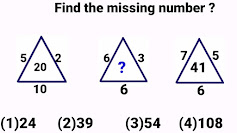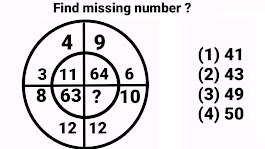Reasoning questions with answers for competitive exams, Reasoning questions with answers for bank exams
Reasoning questions with answers for competitive exams, Reasoning questions with answers for bank exams. These questions of reasoning in latest reasoning questions with answers are very very important for upcoming competitive exams like Bank PO , SSC CGL etc . So let us start solving and understanding these Maths logical reasoning questions with answers.
Reasoning questions with answers for competitive exams and bank exams
Problem # 1
Every number in any upper row is the average of two numbers in the lower row.
Last row /Bottom Row
(9 + 7) ÷ 2 = 16 ÷2 = 8 ( Number in 2nd last row ),
(7 + 5) ÷ 2 = 12 ÷ 2 = 6 ( Number in 2nd last row ),
(5 + 3) ÷ 2 = 8 ÷ 2 = 4 ( Number in 2nd last row ),
2nd last row
(8 + 6) ÷ 2 = 14 ÷ 2 = 7 ( Number in 3rd last row ),
(6 + 4) ÷ 2 = 10 ÷ 2 = 5 ( Number in 3rd last row ),
3rd last row
(7 + 5) ÷ 2 = 12 ÷ 2 = 6 ( Number in Top most row ), And this will be the value of question mark ?
Hence option (1)6 is correct option
Problem # 2
This problem of reasoning have three figures, And every figure consist of five numbers .Out of five numbers one is at centre and four numbers are around the central number.
In every figure central number is the sum of the cube of remaining four numbers.
33 + 23 + 43 + 63 = 27 + 8 + 64 + 216 = 315 (In 1st figure)
113 + 73 + 83 + 63 = 1331 + 343 + 512 +216 = 2402 (In 2nd figure)
13 + 53 + ?3 + 43 = 1 + 125 + ?3 + 64 = 1190 (In 3rd figure)
⇒ ?3 = 1190 - 64 - 125 - 1
⇒ ?3 = 1190 - 190
⇒ ?3 = 1000
⇒ ? = 10
Hence option (3)10 is correct option
Problem # 3
Take the cube of product of 1st two numbers of every row to get the 3rd number in the box.
(2 × 3)3 = 63 = 216 (last number in 1st row)
(3 × 4)3 = 123 = 1728 (last number in 2nd row)
(4 × 5)3 = 203 = 8000 (last number in 3rd row)
(5 × 6)3 = 303 = 27000 (last number in 4th row)
or
Cube of ( 2 × 3 ) = cube of 6 = 216 (last number in 1st row)
Cube of ( 3 × 4) = cube of 12 = 1728 (last number in 2nd row)
Cube of ( 4 × 5) = cube of 20 = 8000 (last number in 3rd row)
Cube of ( 5 × 6) = cube of 30 = 27000 (last number in 4th row)
Option (B)27000 is correct option
Problem # 4
Take the difference of every number with its preceding number
4 - 2 = 2 ( 2nd number - 1st number ) ,
9 - 4 = 5, ( 3rd number - 2nd number ) ,
20 - 9 = 11 , ( 4th number - 3rd number ) ,
40 -20 = 20, ( 5th number - 4th number ) ,
? - 40 , ( 6th number - 5th number )
Now this new series of difference is here
2 , 5 , 11 , 20 , ? - 40
Again take the difference of every number with its preceding number
5 - 2 = 3 ,
11 - 5 = 6 ,
20 - 11 = 9
( ? - 40 ) - 20 = 12 (If the pattern follows)
Now study the difference , this difference is multiple of 3, Hence proceeding in the same manner the next difference will be 12
So ( ? - 40 ) - 20 = 12
? = 12 + 20 + 40
? = 72
Option (2)72 is correct option
Problem # 5
This problem of reasoning have also three figures, And every figure consist of four numbers .Out of four numbers one is at centre and remaining three numbers are around the central number.
In every figure central number is the sum of the number in base line and product of other two numbers . This implies 1st we have to multiply the two numbers which are in the top row then we have to add this sum to the number in bottom line to get the central number in each figure.
(5 × 2) + 10 = 10 + 10 = 20 (1st Figure)
(6 × 3) + 6 = 18 + 6 = 24 ( 2nd Figure)
(7 × 5) + 6 = 35 + 6 = 41 ( 3rd Figure)
Option (1)24 is correct option
Also read this article
Problem # 6
This circle has been divided into four parts and each parts consist of three numbers , Two numbers are written in the outer part of the quadrant and one is at the inner part of the quadrant.
(12 - 8 )³ - 1 = 4³ - 1 = 64 - 1 = 63
(4 - 3 )³ - 1 = 1³ - 1 = 1 - 1 = 0
(9 - 6 )³ - 1 = 3³ - 1 = 27 - 1 = 26
(12 - 10 )3 - 1 = 23 - 1 = 8 - 1 = 7
or
Cube(12 - 8 ) - 1 = 64 - 1 = 63
Cube (4 - 3 ) - 1 = 1 - 1 = 0
Cube( 9 - 6 ) - 1 = 27 - 1 = 26
Cube(12 - 10 ) - 1 = 8 - 1 = 7
Option (1)7 is correct option
Problem # 7
This series is the difference of cube and square of the number starting from 2.
23 - 22 = 8 - 4 = 4 ( 1st number in the series)
33 - 32 = 27 - 9 = 18 ( 2nd number in the series)
43 - 42 = 64 - 16 = 48 ( 3rd number in the series)
53 - 52 = 125 - 25 = 100 ( 4th number in the series)
63 - 62 = 216 - 36 = 180 ( 5th number in the series)
73 - 72 = 343 - 49 = 294 ( 6th number in the series)
83 - 82 = 512 - 64 = 448 ( 7th number in the series)
or
Cube of 2 - square of 2 = 8 - 4 = 4
Cube of 3 - square of 3 = 27 - 9 = 18
Cube of 4 - square of 4 = 64 - 16 = 48
Cube of 5 - square of 5 = 125 - 25 = 100
Cube of 6- square of 6 = 216 - 36 = 180
Cube of 7 - square of 7 = 343 - 49 = 294
Option (3)48 is correct option
Problem # 8
Take the sum of cube roots of two adjoining numbers from the big box in the centre to get the number in outer part of small box .
(343)⅓ + (27)⅓ = 7 + 3 = 10 ( The number in the outer small box)
(27)⅓+ (125)⅓ = 3 + 5 = 8 ( The number in the outer small box)
(125)⅓ + (?)⅓ = 5 + (?)⅓ = 7 ( The number in the outer small box)
⇒ (?)⅓ = 7 - 5
⇒ (?)⅓ = 2 , cubing both sides
⇒ ? = 8
( ?)⅓ + (343)⅓ = (?)⅓ + 7 = 9 ( The number in the outer small box)
⇒ (?)⅓ = 9 - 7
⇒ (?)⅓ = 2 , cubing both sides
⇒ ? = 8
Hence we get 2 in both the cases
Hence Option (C)8 is correct option
Also read these posts on Reasoning
Problem # 9
This problem of reasoning also have three figures, And every figure consist of five numbers .Out of five numbers one is at centre and remaining four numbers are around the central number.
In this problem central number is 2 less than the sum of all the number which are around the middle number.
1st figure
(0 + 6 + 4 + 2) - 2 = 12 - 2 = 10 (middle number in first figure)
2nd figure
( 6 + 2 + 10 + 8) - 2 = 26 - 2 = 24 (middle number in 2nd figure)
3rd figure
(4 + 14 + 12 + 10 ) - 2 = 40 - 2 = 38 (middle number in 3rd figure)
Option (C)38 is correct option
Problem # 10
This circle has been divided into four parts and each parts consist of three numbers , Two numbers are written in the outer part of the quadrant and one is at the inner part of the quadrant.
Difference of digits of numbers in outer circle of any Quadrant - (difference of digits of numbers in inner circle of any Quadrant ) = one in every case
(12 - 8 ) - (6 - 3) = 4 - 3 =1
(4 - 3 ) - (1 - 1) = 1 - 0 =1
(9 - 6 ) - (6 - 4) = 3 - 2 = 1
Similarly we have to proceed like this and choose the correct option whose difference of digits is 1. Look at the option all other option except 2nd option will not satisfies the condition required.
Hence (12 - 10 ) - (4 - 3) = 2 - 1 = 1
Option (2)43 is correct
In this post I discussed Ten Tricky logical reasoning questions+answers , Latest reasoning questions with answers . Comment your valuable suggestion for further improvement.
Reasoning Problems #11
Reasoning Analogy #10
Reasoning Questions #9
Circle Reasoning #8
Ten Box-Problems #7
Ten Reasoning problems #6
Ten-Important-Problem#5
Ten--Tricky-Puzzles #4
Twelve-Figures-Problems#3


















No comments:
Post a Comment
Your valuable suggestions are always acceptable to us for betterment of this website